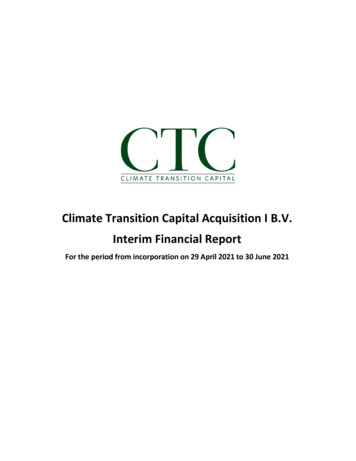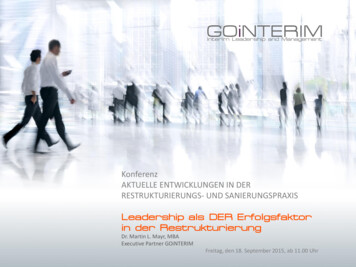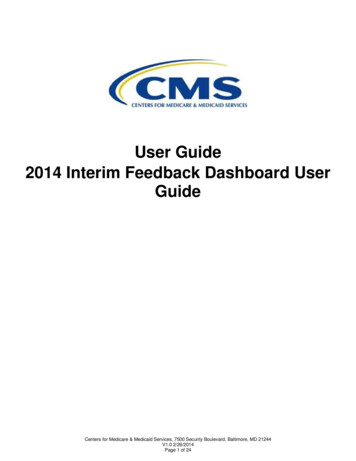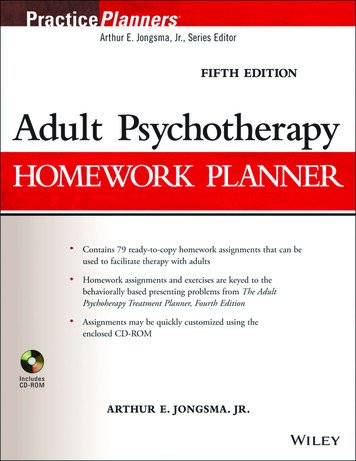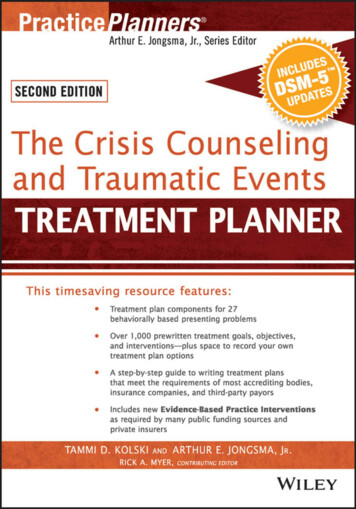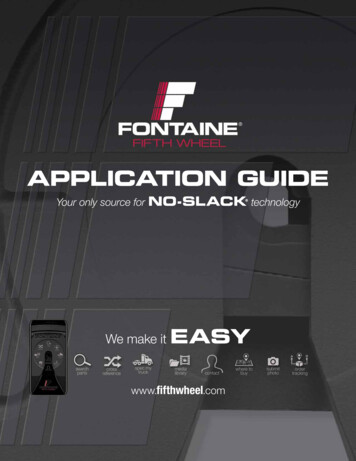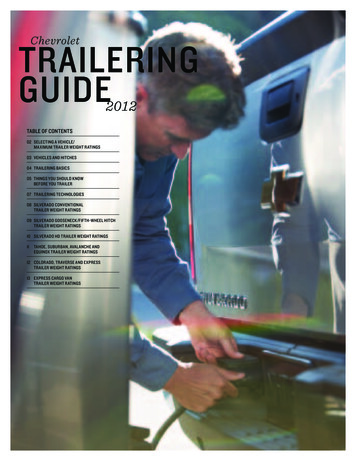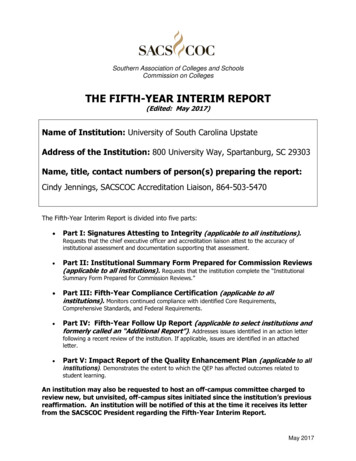
Transcription
Southern Association of Colleges and SchoolsCommission on CollegesTHE FIFTH-YEAR INTERIM REPORT(Edited: May 2017)Name of Institution: University of South Carolina UpstateAddress of the Institution: 800 University Way, Spartanburg, SC 29303Name, title, contact numbers of person(s) preparing the report:Cindy Jennings, SACSCOC Accreditation Liaison, 864-503-5470The Fifth-Year Interim Report is divided into five parts: Part I: Signatures Attesting to Integrity (applicable to all institutions).Requests that the chief executive officer and accreditation liaison attest to the accuracy ofinstitutional assessment and documentation supporting that assessment. Part II: Institutional Summary Form Prepared for Commission Reviews(applicable to all institutions). Requests that the institution complete the “InstitutionalSummary Form Prepared for Commission Reviews.” Part III: Fifth-Year Compliance Certification (applicable to allinstitutions). Monitors continued compliance with identified Core Requirements,Comprehensive Standards, and Federal Requirements. Part IV: Fifth-Year Follow Up Report (applicable to select institutions andformerly called an “Additional Report”). Addresses issues identified in an action letterfollowing a recent review of the institution. If applicable, issues are identified in an attachedletter. Part V: Impact Report of the Quality Enhancement Plan (applicable to allinstitutions). Demonstrates the extent to which the QEP has affected outcomes related tostudent learning.An institution may also be requested to host an off-campus committee charged toreview new, but unvisited, off-campus sites initiated since the institution’s previousreaffirmation. An institution will be notified of this at the time it receives its letterfrom the SACSCOC President regarding the Fifth-Year Interim Report.May 2017
General Directions for the Fifth-Year Interim ReportIn addition to the general directions below that are applicable to all Parts of theFifth-Year Interim Report, please also follow the directions specific for each Part.Submit all parts of your Report to your assigned Commission staff member.1. Materials may be submitted in print form or electronically. If an audit has beenrequested, it must be submitted in print form. If print documents are submitted, please provide 8 copies. Copy alldocuments front and back, double space the copy, and use no less than a 10 pointfont. Staple or soft bind the document. Do not submit in a three-ring binder.Please also provide one print copy without attachments or supportingdocumentation. If electronic documents are submitted, please provide 8 flash/thumbdrives. Copy the report and all attachments onto each flash/thumb drive. Providethe name of the person who can be contacted if the readers have problemsaccessing the information. In addition, provide one flash drive in PDF formatcontaining Parts I, II, III, and V without attachments or supportingdocumentation. Please label this copy distinctively as “without supportingdocuments.”oEach flash/thumb drive must be submitted in a separate paper or plasticenvelope not smaller than 4” x 4” and the envelope should be labeledwith the name of the institution, the title of the report, and a list of theparts of the report that are included. The flash/thumb drive should belabeled with the name of the institution and the title of the report.oBe sure to check the flash/thumb drives before mailing to the Commissionoffice to ensure that all intended documents are included and can beaccessed.2. Reread the report before submission and eliminate all narrative that does not directlyaddress the standard or the issue.3. Provide a separate submission for PART IV, if requested. PART IV can be submitted asa print document or on flash/thumb drive. FOUR COPIES SHOULD BE SUBMITTED.May 2017
Part II: The “Institutional SummaryForm Prepared for Commission Reviews”(Applicable to all institutions)Directions: Please include Part II with Parts I, III, and V on the same electronicdevice or with the same print document. It should not be combined with Part IV.GENERAL INFORMATIONName of Institution: University of South Carolina UpstateName, Title, Phone number, and email address of Accreditation Liaison:Cindy Jennings, SACSCOC Accreditation Liaison, 864-503-5470, cjennings@uscupstate.eduName, Title, Phone number, and email address of Technical Support person for theCompliance CertificationLuke VanWingerden, Interim Vice Chancellor for Information Technology and Data ServicesIMPORTANT:Accreditation Activity (check one):XSubmitted at the time of Reaffirmation OrientationSubmitted with Compliance Certification for ReaffirmationSubmitted with Materials for an On-Site Reaffirmation ReviewSubmitted with Compliance Certification for Fifth-Year Interim ReportSubmitted with Compliance Certification for Initial Candidacy/Accreditation ReviewSubmitted with Merger/Consolidations/AcquisitionsSubmitted with Application for Level ChangeSubmission date of this completed document: March 15, 2018May 2017
EDUCATIONAL PROGRAMS1. Level of offerings (Check all that apply)XXDiploma or certificate program(s) requiring less than one year beyond Grade 12Diploma or certificate program(s) of at least two but fewer than four years of work beyondGrade 12Associate degree program(s) requiring a minimum of 60 semester hours or the equivalentdesigned for transfer to a baccalaureate institutionAssociate degree program(s) requiring a minimum of 60 semester hours or the equivalentnot designed for transferFour or five-year baccalaureate degree program(s) requiring a minimum of 120 semesterhours or the equivalentProfessional degree program(s)Master's degree program(s)Work beyond the master's level but not at the doctoral level (such as Specialist inEducation)Doctoral degree program(s)Other (Specify)2. Types of Undergraduate Programs (Check all that apply)XXXOccupational certificate or diploma program(s)Occupational degree program(s)Two-year programs designed for transfer to a baccalaureate institutionLiberal Arts and GeneralTeacher PreparatoryProfessionalOther (Specify)GOVERNANCE CONTROLCheck the appropriate governance control for the institution:Private (check one)Independent, not-for-profitName of corporation ORName of religious affiliation and control:Independent, for-profit *If publicly traded, name of parent company:May 2017
XPublic state * (check one)Not part of a state system, institution has own independent boardXPart of a state system, system board serves as governing boardPart of a state system, system board is super governing board, local governing board hasdelegated authorityPart of a state system, institution has own independent board* If an institution is part of a state system or a corporate structure, a description of the system operationmust be submitted as part of the Compliance Certification for the decennial review. See Commissionpolicy “Reaffirmation of Accreditation and Subsequent Reports” for additional direction.”INSTITUTIONAL INFORMATIONFOR REVIEWERSDirections:Please address the following and attach the information to this form.1. History and CharacteristicsProvide a brief history of the institution, a description of its current mission, an indication of its geographicservice area, and a description of the composition of the student population. Include a description of anyunusual or distinctive features of the institution and a description of the admissions policies (open,selective, etc.). If appropriate, indicate those institutions that are considered peers. Please limit thissection to one-half page.The University of South Carolina (USC) Upstate is a public university located in the Upstateregion of South Carolina and is a regional comprehensive campus of the state’s flagship school,the University of South Carolina. USC Upstate is committed to fulfilling regional and stateworkforce needs, making it a major engine of social and economic development.Established in 1967, USC Upstate, then known as the Spartanburg Regional Campus of theUniversity of South Carolina, was established to avert a serious health-care worker shortagewhen Spartanburg General Hospital announced it was phasing out its diploma for registered. Acitizens’ committee investigated the situation and ultimately requested that Spartanburg beincluded in the University of South Carolina System. In the fall of 1967, 177 students beganclasses on the first floor of the Spartanburg General Hospital Nursing Residence. Enrollmentcontinued to increase and in 1975 the school became a four-year university and was renamed theUniversity of South Carolina Spartanburg. The school would later become USC Upstate in 2004in an effort to better identify with the region it serves with classes being offered in Spartanburg,Greenville and online.USC Upstate’s main campus is located in Spartanburg County along the Interstate 85 corridorconnecting Atlanta and Charlotte, one of the fastest growing regions in the nation and home tomore than one million people with the highest per capita international investment of any countyin the nation. The university offers more than 40 bachelor’s degree programs in the liberal artsand sciences, business administration, nursing and teacher education, as well as master’s degreesin education, nursing and informatics. By continually adding new academic programs, USCMay 2017
Upstate is preparing graduates to take leadership positions in area businesses and in theircommunities, and in turn, helping the region to grow and prosper.Now in its 50th year, the university comprises a diverse and dynamic community of about 6,000students from 26 states and 17 countries. USC Upstate is a wonderful blend of traditional andnontraditional students. About 30,000 students have earned their degrees from USC Upstate andnearly 85 percent of those alumni choose to remain in the Upstate to build their lives and careers.2. List of DegreesList all degrees currently offered (A. S., B.A., B.S., M.A., Ph.D., for examples) and the majors orconcentrations within those degrees, as well as all certificates and diplomas. For each credential offered,indicate the number of graduates in the academic year previous to submitting this report. Indicate termdates.May 2017
May 2017
May 2017
3. Off-Campus Instructional Locations and Branch Campuses(Please note: This section has been extensively revised.)List all locations where 50% or more credit hours toward a degree, diploma, or certificate can beobtained primarily through traditional classroom instruction. Report those locations in accord with theCommission’s definitions and the directions as specified below.Off-campus instructional sites—a site located geographically apart from the main campus at which theinstitution offers 50 % or more of its credit hours for a diploma, certificate, or degree. This includes highschools where courses are offered as part of dual enrollment. For each site, provide the informationbelow. The list should include only those sites reported and approved by SACSCOC. Listingunapproved sites below does not constitute reporting them to SACSCOC. In such cases when aninstitution has initiated an off-campus instructional site as described above without prior approval bySACSCOC, a prospectus for approval should be submitted immediately to SACSCOC.Name of SiteUSC UpstateGreenvilleCampusUSC Upstateat SumterPhysical Address(street, city, state,country) Do notinclude PO Boxes.255 S.PleasantburgDrive, Greenville,SC 29607200 Miller Road,Sumter, SC 29150DateApproved bySACSCOC19871996DateImplementedby theinstitutionEducationalprograms offered(specific degrees,certificates,diplomas) with 50%or more creditshours offered ateach siteIs the sitecurrentlyactive? (At anytime during thepast 5 years,have studentsbeen enrolledand coursesoffered? If not,indicate thedate of mostrecent activity.)1987BA, EarlyChildhoodEducation; BA,ElementaryEducation; BA,Middle LevelEducation; MS,Informatics; BA,InformationManagement andSystems; BS,EngineeringTechnologyManagement; BS,Nursing; RN-BSN;BA or BS,InterdisciplinaryStudiesYes1996BA, EarlyChildhoodEducation; BA,ElementaryEducation; M.Ed.,Early ChildhoodEducation; M.Ed.,ElementaryEducationYesMay 2017
Institutions with off-campus instructional sites at which the institution offers 25-49% credit hours for adiploma, certificate, or degree—including high schools where courses are offered as dual enrollment—arerequired to notify SACSCOC in advance of initiating the site. For each site, provide the informationbelow. Not applicableName of Site(Indicate if siteis currentlyactive orinactive. Ifinactive, date oflast courseofferings anddate ofprojectedreopeningPhysical Address(street, city, state,country) Do notinclude PO Boxes.Date NotifiedSACSCOC bySACSCOCDateImplementedby theinstitutionEducationalprogramsoffered (specificdegrees,certificates,diplomas) with 2549% credit hoursoffered at each siteIs the sitecurrently active?(At any timeduring the past 5years, havestudents beenenrolled andcourses offered?If not, indicatethe date of mostrecent activity.)Branch campus—an instructional site located geographically apart and independent of the main campusof the institution. A location is independent of the main campus if the location is (1) permanent in nature,(2) offers courses in educational programs leading to a degree, certificate, or other recognizededucational credential, (3) has its own faculty and administrative or supervisory organization, and (4) hasits own budgetary and hiring authority. The list should include only those branch campuses reportedand approved by SACSCOC. Listing unapproved branch campuses below does not constitute reportingthem to SACSCOC. A prospectus for an unapproved branch campus should be submitted immediately toSACSCOC. Not applicableName ofBranchCampusPhysical Address(street, city, state,country) Do notinclude PO Boxes.DateApproved bySACSCOCDateImplementedby theinstitutionEducationalprograms (specificdegrees,certificates,diplomas) with 50%or more creditshours offered at thebranch campusIs the campuscurrentlyactive? (At anytime duringthe past 5years, havestudents beenenrolled andcoursesoffered? If not,indicate thedate of mostrecent activity.)May 2017
4. Distance and Correspondence EducationProvide an initial date of approval for your institution to offer distance education. Provide a list of creditbearing educational programs (degrees, certificates, and diplomas) where 50% or more of the credithours are delivered through distance education modes. For each educational program, indicate whetherthe program is delivered using synchronous or asynchronous technology, or both. For each educationalprogram that uses distance education technology to deliver the program at a specific site (e.g., asynchronous program using interactive videoconferencing), indicate the program offered at each locationwhere students receive the transmitted program. Please limit this description to one page, if possible.USC Upstate has been approved to offer greater than 50% of undergraduate course credits throughdistance education modality and technology. Initial date of approval to offer distance education: 1999.Several Upstate degree programs have been approved to be offered 50% to 100% online. Upstate uses theBlackboard Learn technology platform for online course delivery.Synchronous interactive video-conferencing sessions are supported with the Polycom interactive videosystems installed in select classroom on the Spartanburg main campus and at the University Center inGreenville. Synchronous instruction is also supported using Adobe Connect and Skype for Businessaccording to faculty preference. No full programs rely exclusively on synchronous technology.USC Upstate does not offer correspondence courses, certificates, or degree programs.Degree programs at USC Upstate with more than 50% course credits available through onlinemodality:DegreeTitleMary Black School of NursingBSRN-BSNMSNursing (Clinical Nurse Leader)College of Arts and SciencesBSCriminal JusticeBSEngineering Technology ManagementBAInformation Management & SystemsBAHealth InformaticsModality/Technology100% online asynchronous95% online asynchronous/synchronous100% online asynchronous90% online asynchronous/synchronous100% online asynchronous100% online asynchronousMay 2017
5. Accreditation(1) List all agencies that currently accredit the institution and any of its programs and indicate thedate of the last review by each.(2) If SACS Commission on Colleges is not your primary accreditor for access to USDOE Title IVfunding, identify which accrediting agency serves that purpose.Not applicable(3) List any USDOE recognized agency (national and programmatic) that has terminated the institution’saccreditation (include the date, reason, and copy of the letter of termination) or list any agency fromwhich the institution has voluntarily withdrawn (include copy of letter to agency from institution).Not applicable(4) Describe any sanctions applied or negative actions taken by any USDOE-recognized accreditingagency (national, programmatic, SACSCOC) during the two years previous to the submission of thisreport. Include a copy of the letter from the USDOE to the institution.Not applicableMay 2017
6. Relationship to the U.S. Department of EducationIndicate any limitations, suspensions, or termination by the U.S. Department of Education in regard tostudent financial aid or other financial aid programs during the previous three years. Report if onreimbursement or any other exceptional status in regard to federal or state financial aid.The institution has no limitations, suspensions and termination by the U.S. Department of Education inregard to student financial aid or other financial aid programs during the previous three years.Document HistoryAdopted: September 2004Revised: March 2011Revised: January 2014May 2017
Part III: The Fifth-Year Compliance Certification(Applicable to all institutions)Directions:(1)Please access the document “Directions for Completion of Part III of theFifth-Year Interim Report” for directions and guidelines for completing PartIII.(2)Please include Part III with Parts I, II, and V on the same electronic device orwith the same print document. It should not be combined with Part IV.(3)For each Core Requirement, Comprehensive Standard, and FederalRequirement listed below, the institution should make a determinationregarding compliance, place an “X” in the appropriate box, explain the reasonfor the institution’s findings, and provide documentation in support of itsdetermination.ComplianceThe institution found that it meets the requirement and provides a convincingargument in support of its determination and a list of documents (or electronicaccess to the documents) demonstrating compliance.Non-ComplianceThe institution found that it does not meet the requirement and provides thereason for checking non-compliance, a description of plans to comply, and a listof documents that will be used to demonstrate future compliance.Note: (1) Unless an institution is required to submit financial documents requested in Part IV, noadditional financial information is required due to the annual submission of Institutional Finance Profiles.(2) The standards identified in this part of the report reflect the criteria of the U.S. Department ofEducation.1. The number of full-time faculty members is adequate to support the mission of the institution and toensure the quality and integrity of each of its academic programs. (Core Requirement /Faculty AppointmentThe University of South Carolina Upstate (USC Upstate) employs a strong instructional base offaculty – full-time and part-time. The foundation that undergirds measures to assure our mission-drivenassurance of sufficient faculty to maintain quality and integrity of academic programs is described inChapter 5 of the Faculty Manual,“ academic units should rely primarily on tenure-track professors with terminal degrees in theirarea of teaching emphasis. A number of factors cause reliance on full-and part-time, non-tenure-
track faculty, including vital professional experience held by those without a terminal degree,accreditation standards requiring clinical experience, staffing flexibility within the academic unit,and budget constraints”.Full-time faculty are comprised of tenured, tenure track, and non-tenured members teaching at least 6credit hours per semester. The typical workload for full-time, tenure track faculty is 4/4 – or 12 credithours a semester. There are areas where this is less - in keeping with standards set by additional programaccreditations (e.g. business, computer science, graduate faculty); or more given periodic higherinstructional needs. Tenured and tenure-track ranks include assistant professor, associate professor, andprofessor.Tenure at USC Upstate matches the conventions practiced at many universities across thecountry: after a probationary period, tenure-track faculty members may be granted tenure, whichrecognizes their positive contributions to the University with increased job security and expandedparticipation in peer review and other responsibilities. Tenure-track faculty members are evaluatedaccording to their contributions in teaching, scholarly and creative production, and service. Conditions forappointment and advancement in rank are presented in the Faculty Manual.Full-time, non-tenure-track faculty members are hired at the rank of Instructor. Instructorstypically maintain a higher teaching load – 5/5 or 15 credit hours a semester - than tenure-track faculty,and they are evaluated during administrative review accordingly with less weight given to scholarly andcreative production and service. Initial appointments are one-year; subsequent appointments are for up tothree-years. Each candidate for appointment at the rank of instructor is expected to have earned themaster’s degree and to offer evidence or promise of competence in teaching. Many of these faculty areemployed in the Schools of Nursing and Education and are highly skilled in their roles as nurses orteachers. An instructor who holds at least a master’s degree and has held a full-time faculty appointmentat USC Upstate for a minimum of six years may apply for promotion to Senior Instructor. Part-time,visiting or temporary faculty are not eligible for rank or tenure.All faculty appointments are typically for 9 months for full-time faculty and 1 semester foradjuncts. Program directors and department chairs receive a ½ reduction in their teaching load for theterm of their appointment, teaching at least 6 hours per semester (teaching constitutes at least 50% of theirduties). Faculty teaching load when one or more graduate courses are taught is nine credit hours (twelvehours for instructors) of instruction per semester.Faculty Roles and ResponsibilitiesChapter 3 of the Faculty Manual describes the customary three-fold role of faculty members at USCUpstate including teaching, service and scholarship. The teaching component encompasses facultyresponsibility for classroom instruction (including syllabus design and communication of student learningobjectives), academic advisement, fidelity to and oversight of curriculum in their respective programs,and all aspects of the general conduct of the teaching role (office hours, grading, etc.). The servicecomponent scaffolds responsibility of faculty to support the university mission through service to theinstitution, the community, and their profession. Faculty responsibilities in the area of scholarship andcreativity may vary depending on academic discipline and are guided by individual unit-specific criteriawith examples of performance indicators. Faculty may apply knowledge, publish in a variety of forms,conduct scholarly public presentations, conduct applied research, etc.Student Faculty Ratios1USC Upstate strives to maintain low student faculty ratios to ensure quality teaching-learninginteractions. The ratio has remained stable over the reported 3-year period. The stability of this ratioreflects the institution’s emphasis on quality and integrity of academic programs.1Source: Visual Fact Book/Enrollments-Student-Faculty Ratio
Fall 201417:1Fall 201517:1Fall 201618:1Student faculty ratios compared to peer institutionsInstitutionStateUniversity of NorthAlabamaMidwestern StateUniversityAlabamaNicholls StateUniversityLouisianaMissouri SouthernState UniversityCalifornia StateUniversity, 2 credit hoursper semester12undergraduatehours persemester12undergraduatehours persemester12 credit hoursper semester12 weightedteaching unitsFT Undergrad Student to Faculty Ratio201420152016172120171818201920181820232223
Numbers of Faculty
**Please note that the numbers of courses, enrollments, and credit-hour production labeled as part-time include instances where at least 9 full-timefaculty members taught courses outside of their home department. In these cases (counted as part-time), students benefited from the expertise ofthe full-time faculty member.
Part-time faculty at USC Upstate serve an invaluable role as many times their teaching is informed andenriched by their relevant real-world experience and expertise. Part-time faculty meet the sameeducational requirements as full-time faculty. Neither rigor expected in the teaching of the part-timefaculty nor the course requirements are different in sections taught by part-time faculty. Part-time facultyare mentored/guided by department chairs and colleagues in their area to ensure that their instruction isfaithful to program and course level learning objectives.Separate additional accreditations and continuous quality monitoring for the professional schools includesattention to adequacy of numbers of faculty. Also, adequate staffing per state requirements mandates thatin the school of education clinical courses for student teaching are capped at 14 to ensure that students canbe adequately observed by a faculty member. In addition, directed student teaching is supervised by auniversity supervisor – professionals with many years of classroom and clinical experience hired toobserve student teachers in the fields. These supervisors are assigned to no more than 7 students. TheSouth Carolina Board of Nursing specifies that “The maximum ratio of faculty to students in an acuteinpatient setting where students are providing direct patient care is one faculty member to eight students(1:8).” (Nurse Regulations, Chapter 91, Section 91-11.C.1.a.)In addition to institutional guidance regarding numbers of faculty (excerpted above from the FacultyManual), multiple other variables may influence numbers of full-time and part-time faculty needed tomeet instructional needs in a given semester. For example, during the academic years reported, facultymembers from in the department of history, political science, philosophy and American studies served inthe following service roles on campus that required they receive reassigned time (thus increasing the needfor part-time faculty) during those semesters:1. An associate professor of history served 2 years as chair of the faculty senate.2. A professor of history currently serves as associate dean of the college of arts and sciences.3. An associate professor of philosophy served as faculty athletic representative.2. The institution provides student support programs, services, and activities consistent with its missionthat are intended to promote student learning and enhance the development of its students. (CoreRequirement 2.10)XComplianceNon-ComplianceNarrative:USC Upstate provides a broad range of mission-aligned student support services intended to promotelearning, enrich, and enhance the experience and development of its students.In alignment with its mission to provide baccalaureate education primarily to citizens of the Upstate ofSouth Carolina.“Curricula and services are designed for the University’s students, four to seven thousand inheadcount, who are diverse in background, age, race, ethnicity, educational experience andacademic goals. Students are drawn in large proportion from the Upstate where many choose toremain for their careers .both traditional and working professionals are served across theregion the University promotes global perspectives across its programs. Supporting theregional employment objectives of its students, it provides extensive experiential learningopportunities.”22USC Upstate Mission Statement
Students at USC Upstate3Characteristics of the USC Upstate student body (Fall semester 2016) include:USC Upstate Student ProfileCharacteristics of USC Upstate student body for Fall 2016 semester. Total enrollment 5821* First-time, full-time freshmen: 263 men, 498 women* Total Transfer students (degree seeking): 757* 81% of Upstate student body is 24* 80% of undergraduates are enrolled Full-Time* 84% live off campus or commute with only 16% living in campus Housing** 64% of undergraduate students are female* 56% of all students are white, 27% black or African American, 5% Hispanic, 3% Asian* 214 students were enrolled in all online program*** 371 students taking at least one course at Greenville Campus FA16*** 55 students taking at least one course at Sumter Campus FA16*** 1,543 Non-traditional students ( 25, veteran, parent) *** 243 Graduate students **IPEDS 2016-2017 Fall Enrollment Report for FA16, p. 43**Common Data Set, FA16, Visual Factbook Enrollment, Student Life*** Cognos Data Extraction from Banner for FA16Students at USC Upstate are drawn from mainly from the upstate of South Carolina. The following tablesummarizes the 10 highest SC counties ter86Charleston81Laurens7910 Highest SC Counties EnrolledEnrollment ServicesThe division of enrollment services provides administrative p
and sciences, business administration, nursing and teacher education, as well as master's degrees in education, nursing and informatics. By continually adding new academic programs, USC . May 2017 Upstate is preparing graduates to take leadership positions in area businesses and in their



